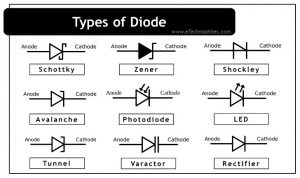Last updated on March 30th, 2024 at 11:42 am
A diode is a two-terminal electronic component that allows the current to flow in one direction. Based on the applications, they are of different types. They are used in voltage multiplier circuits, voltage-shifting circuits, voltage-limiting circuits, and voltage-regulator circuits. Some of them are listed below with their applications.
List of different types of diodes
Here’s the complete list of different types of diode that is ever made:
- Zener diode
- Light Emitting diode
- Rectifier diode
- Schottky diode
- Laser diode
- Varactor diode
- Transition voltage suppression diode(TVS)
- Tunnel diode
- Vacuum diode
- Shockhly diode
- Stabistors or forward reference diode
- Super Barrier diode
- PIN diode
- Gold-doped diode
- Snap-off or Step recovery diode
- Thermal diode
- Photodiode
- Gunn diode
- Crystal diode
- Avalanche diode
- Constant current diode
The most common diodes among these are explained in detail below.
Zener diode

A Zener diode is a heavily doped semiconductor device designed to operate in the reverse direction. It conducts when the voltage in reverse bias mode reaches a specific limit. This voltage is known as Zener voltage or reverse breakdown voltage.
Commonly used Zener diodes are of the BZX55 and BZX85 series.
What is reverse breakdown voltage?
It is the voltage at which the Zener diode starts conducting current, and operates continuously in the reverse-bias mode without getting damaged. This voltage can vary from 2.4 V to about 200 V; it can go up to 1 kV. The maximum voltage for the surface-mounted device (SMD) is about 47 V.
Applications
- In voltage regulation
- As reference elements
- As surge suppressors
- Switching applications
- Clipper circuits
Light Emitting Diode(LED)

LED emits light when electric current flows through it. When the electrons in the semiconductor recombine with holes then it releases energy in the form of photons. The emitted light color depends on the energy gap of the semiconductor used.
Miniature LEDs, High-Power LEDs, Flash LED, Bi and Tri-Colour, Red Green Blue LEDs, Alphanumeric LEDs, and Lighting LEDs are different types of LEDs.
Characteristics
- Low power consumption
- Long Life
- Monochromatic
- Low operational voltage
Applications
- Indicators
- 7 segment LED displays
- Displays
Laser diode
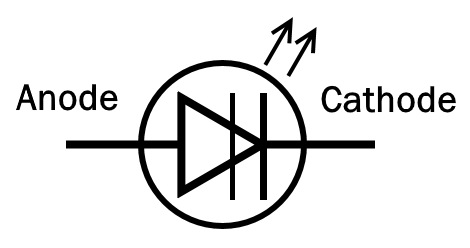
LASER stands for Light Amplification by Stimulated Emission of Radiation. It is like a light-emitting diode that emits a high-powered light through a glass lens to reduce signal loss. It uses a p-n junction for producing coherent radiation with the same frequency and phase which is either in the visible or infrared spectrum.
U-LD-650543A is a 650nm Red laser diode.
Characteristics
- Highly directive
- Can travel long distance
- It exhibits monochromaticity
- It is a coherent source of light
- Consumes less power
- Cost is low
Applications
- Data recording and reading on CD-ROMs, DVDs, and Blu-ray Discs
- Fiber optic communications
- Laser material processing like cutting, drilling, etc
- Medical Applications: Dental treatment, Elimination of unwanted tissues and tumors
Varactor diode

A Varactor diode is a reverse-biased p-n junction diode, whose capacitance can be varied electrically. These diodes are also known as varicaps, tuning diodes, voltage variable capacitor diodes, parametric diodes, and variable capacitor diodes.
The one end of a symbol consists of the diode, and the other end has two parallel lines that represent the conductive plates of the capacitor. The gap between the plates shows their dielectric.
The Varactor diode is used for storing the charge not for flowing the charge. In the forward bias, the total charge stored in the diode becomes zero, which is undesirable. Thus, the Varactor diode always operates in the reverse bias.
Zetex 830 series, MV210, and BB910 are some of the varactor diodes.
Advantages
- Low noise
- Low cost
- Small in size and weightless
Applications
- RF industry
- Voltage controlled oscillator
- Auto tuning
- Adjustable circuits
- Automatic Frequency Controllers
Schottky diode

It is also known as the hot-carrier diode or Schottky barrier diode. It is a type of metal-semiconductor diode having a low forward voltage drop and a very fast switching speed.
In Schottky diodes, metals such as aluminum or platinum replace the P-type material of normal PN junctions.
What is the Schottky barrier?
In Schottky diodes, a junction is formed between the metal and N-type semiconductor. This junction is known as a metal-semiconductor junction or M-S junction. A metal-semiconductor junction formed between a metal and n-type semiconductor creates a barrier or depletion layer known as a Schottky barrier.
The main advantage is that the forward voltage drop of a Schottky Diode is considerably less (that is 0.15 to 0.45 V) than that of a conventional silicon PN junction diode, which is 0.7 volts.
T0247 SR3010, TO218 STPS3045, DO35 SD103B, etc are some of the Schottky diodes.
Characteristics
- Low forward voltage drop
- Fast reverse recovery(from ON to OFF state)
- Low turn-on voltage(0.2 to 0.3 V)
- Low junction capacitance
- High current density
- High reverse saturation current
- Less Unwanted noise than ordinary PN junction
Applications
- RF mixers
- Solar cell applications
- Logic circuits
- Power supplies
TVS diodes
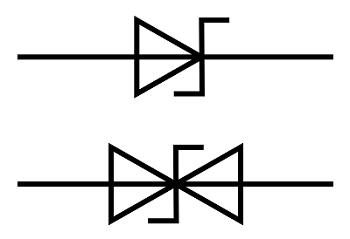
A transient-voltage-suppression (TVS) diode is also known as transil or thyrector. It protects electronic components from voltage spikes induced on connected wires or clamps the voltage at a set amount before going into the circuit. TVS Diodes are available in both unidirectional (unipolar) and bidirectional (bipolar) diodes circuit configurations.
How do TVS diodes protect circuits?
The diagram given above shows how a TVS diverts transient current to the ground. The voltage received at the load terminal is always equal to the TVS clamping Voltage level.
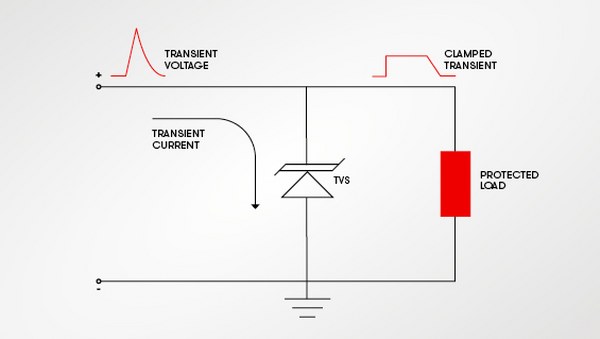
SMBJ15CA, SM4T28CAY, and ESD9L5.0ST5G are some of the circuit-protecting TVS diodes.
Characteristics
- Low incremental surge resistance
- Unidirectional and bidirectional polarities are available
- Reverse stand-off voltages range from 3.3V to 600V
- Surface-mount power ratings from 200W to 5kW
- Axial lead power ratings from 400W to 30kW
- High current protection available up to 20kA
Applications
- Automotive
- Airplanes
- I/O interfaces
- Telecom
- Vcc bus and other vulnerable circuits
- Computers
- Industrial
- Consumer electronics
Tunnel diode

A tunnel diode is also known as an Esaki diode. It is a heavily doped PN junction diode that exhibits negative resistance and high conductivity due to the tunneling effect. They are usually made from germanium, but can also be made from gallium arsenide and silicon materials.
What is the concentration impurity in a Tunnel diode?
The concentration of impurity in the normal PN-junction diode is about 1 part in 108. While in the tunnel diode, the concentration of the impurity is about 1 part in 103.
1N3716, IN3712, and IN3714 are some of the tunnel diodes.
Note: The negative resistance is used to achieve oscillation.
What is tunneling?
Tunneling is the phenomenon of conduction in semiconductor material. In this process, the charge carrier punches the barrier instead of climbing through it.
Characteristics of Tunnel Diode
- Long life
- Low noise
- High-speed operation
Applications
- Very fast switching device in computers
- High-frequency oscillators and amplifiers
- Logic memory storage devices
- FM receivers
Rectifier diodes

A rectifier diode is a two-lead semiconductor that allows current to pass in only one direction. Generally, the P-N junction diode is formed by joining together n-type and p-type semiconductor materials. It is used to rectify AC (alternating current) to DC (direct current) using the rectifier bridge application.
What are rectifier diodes made of?
The rectifier diodes are generally made of Silicon. But, Ge or gallium arsenide-based semiconductor materials are used to make rectifier diodes. They are capable of conducting high electric current values.
1N4001, 1N4002, 1N4003, 1N4004,1N4007, 1N5002, 1N5006, 1N5008 are some commonly used rectifier diodes.
Applications
- Rectifying a voltage, such as turning the AC into DC voltage
- Isolating signals from a supply
- Voltage Reference
- Controlling the size of a signal
- Mixing signals
- Detection signals
- Lighting systems
Vacuum diodes
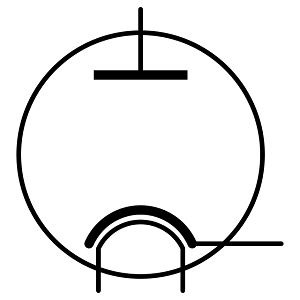
This diode is made with vacuum tubes. It consists of two electrodes (anode & cathode) enclosed in a vacuum tube. It allows the current to flow from cathode to anode and blocks the current from anode to cathode. The cathode of this diode generally emits free electrons so it is called an emitter whereas an anode gathers free electrons, so-called a collector.
UBF 89, and T-6DC8 are some vacuum diodes.
Characteristics
- Electric flow within the vacuum
- Big in size
- High power applications
- Low input impedance
- Less temperature dependence
Applications
- Radios, microwave ovens, Televisions, mobile phones, Wi-Fi transmissions, and even satellite & radar communication devices
- Cathode ray tubes, X-Ray tubes, photomultipliers & magnetrons.
- Vacuum Electron Devices
- Vacuum Panel Displays
Shockley diode

It is a four-layer (P-N-P-N) and two terminal (anode & cathode) diode. The two transistors’ equivalent circuit of this diode is illustrated below. In this circuit, the collector terminal of the ‘T1’ transistor is connected to the base terminal of the T2 transistor.
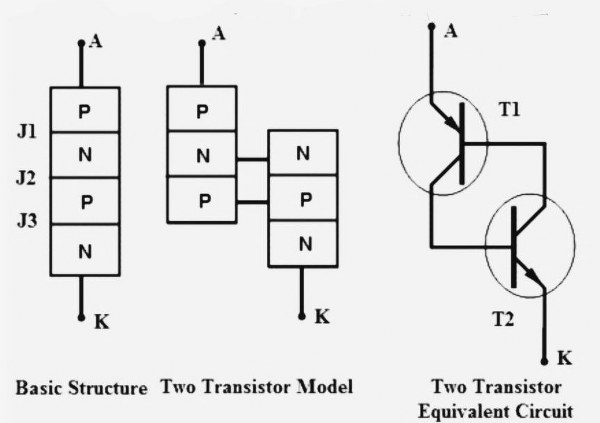
Shockley Diode is not widely available commercially. Still, it forms the backbone of devices like Diac, Triac, and SCR.
Note: This diode was the first device in the thyristor family.
Characteristics of Shockley diode
- Fast recovery time
- Low turn-on voltage
- Less loss of energy at higher frequencies
- Forward voltage drop is low so power dissipation is also low
Applications
- This diode can be used as a trigger switch within the circuits to switch ON an SCR.
- It can be used in relaxation oscillators.
FAQs
Why Zener diodes are provided in DC circuits?
They are provided in DC circuits primarily for voltage regulation purposes.
What is the full form of PN junction?
The full form of the PN junction is “Positive-Negative junction.”
What is knee voltage?
The “knee voltage” is the threshold voltage at which a semiconductor diode begins to conduct appreciable current.
